Week 5 | Viruses and Prions
1/91
There's no tags or description
Looks like no tags are added yet.
Name | Mastery | Learn | Test | Matching | Spaced |
|---|
No study sessions yet.
92 Terms
when was the first virus “discovered”?
in 1890s
are viruses organisms? are they alive?
viruses are not considered fully living organisms because they cannot reproduce or carry out metabolism on their own; they require a host cell
what role did viruses play in the evolution of life?
viruses may have contributed ot genetic diversity and evolution by transferring genes between organisms and influencing cellular evolution
what are the distinctivr characteristics of viruses
acellular
consists of either DNA OR RNA (never both)
enclosed in a protein coat
Surface “spikes” give them high specificity to attach to a host cell
Lacks enzymes and protein synthesis machinery
require a host to reproduce
ultramicroscoptic in size!
how can a particle so small, simple, and seemingly insignificant cause disease and death?
viruses hijack host cells to replicate, often killing or damaging the host cells, which lead to disease
what is the connection between viruses and cancer?
some viruses alter host cell DNA or interfere with cell-ccle regulation, which may lead to cancer (oncogenic viruses)
viruses are referred to as either __________ or _________ not _________ or _______
active; inactive; dead; alive
true or false: viruses cannot multiple unless they invade a specific host cells and must instruct the genetic and metabolic machinery of the host cell to malke and release new viruses
true
what are the different category to which viruses are categorize by?
hosts and diseases they cause
structure
chemical compositions
similarities in genetic makeup
what is the largest and smallest viruses?
smallest: parvovirus
largest: herpes
what part of a virus is often stolen from the host cell and used as a camouflage?
the envelope
true or false: a viral envelope helps the virus hide from the host immune system
true; the envelope is derived from the host membrane and can help with the immune evasion
what is the viral core?
the core houses the virus’s nucleic acid (genome) and associated proteins
what term describes the complex of viral nucleic acid plus capsid proteins?
nucleocapsid
compared with a typically cell, how many genes do viruses usually have?
a very small umber of genes compared with a cell
what is the capsid in a virus?
the shell surrounding the nucleic acid
what is the nucleocapsid in a virus?
capsid and nucleic acid together
true or false: the envelope are not found in all viruses
true
what does it mean that some viruses are considered to be “naked”?
they lack an envelope
their entire structure is just nucleocapsid which is made up of the nucleic acid and the capsid shell
what do both naked and envelope viruses have on their outer surface?
both have outer surface proteins called spikes
what is the function of viral spikes on viruses?
spikes allow the virus to attach to and to be absorbed into the host cell
how do naked and enveloped viruses differ in behavior?
they behave different in how they enter and leave a host cell
entry: enveloped viruses enter ost cells either by fusion of their envelope with the host membrane or by endocytosis while naked viruses can only enter by endocytosis since they lack a membrane to fuse
exit: enveloped viruses are typically released by budding which allow them to acquire their envelope from the host cell membrane and often does not immediately kill the host cell but naked viruses are usually release through cell lysis, which destroys the host cell in the process
what is a helical capsid and what is its general capsid?
a capsid with rod-shaped capsomers that coil around the viral genome, forming a helix or spiral structure
the nucleic acid is located inside the hollow tub
found in many RNA viruses (e.g., influenza, rabies)
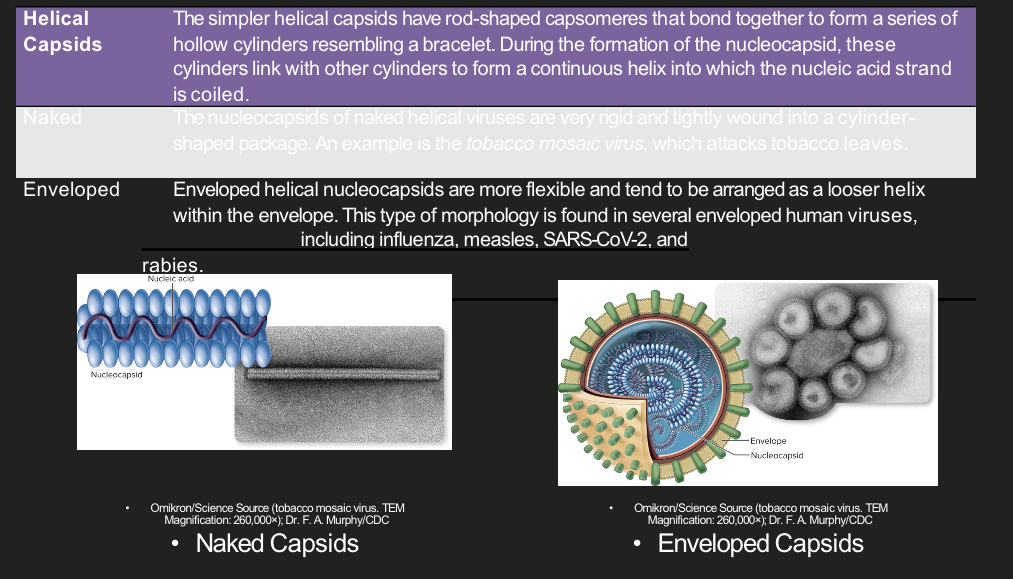
what is an icosahedral capsid and what are the general characteristics?
a capsid with 20 identical triagnular faces and 12 corners, forming a roughly spherical shape
provides maximum internal volume with minimal protein
found in many DNA viruses (e.g., adenovirus, poliovirus)
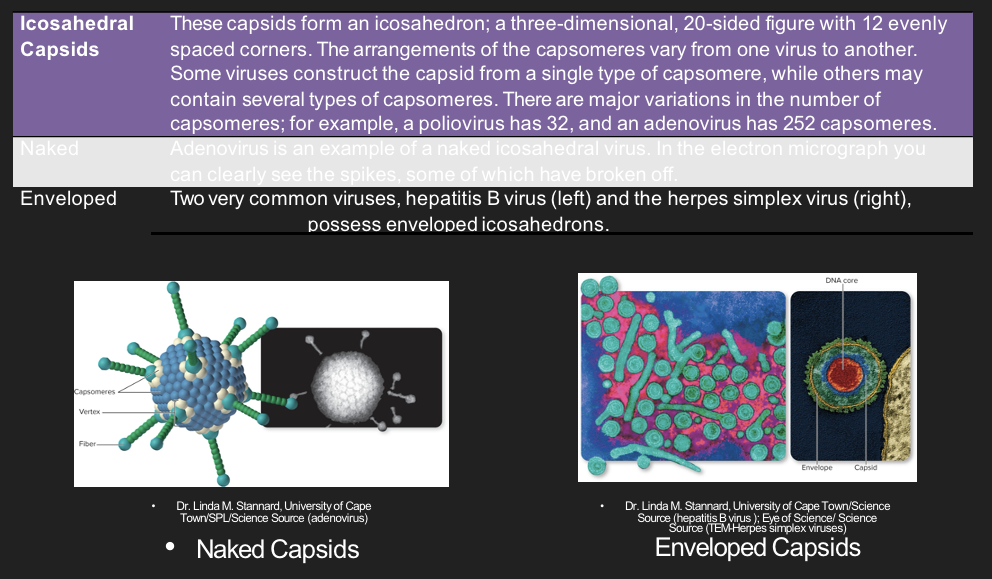
what is a complex capsid and what are the general characteristics?
a capsid that is neither purely helical nor icosahedral in structure
often have additional structures such as tails, outer walls, or complex symmetry
typically of bacteriophages and poxviruses
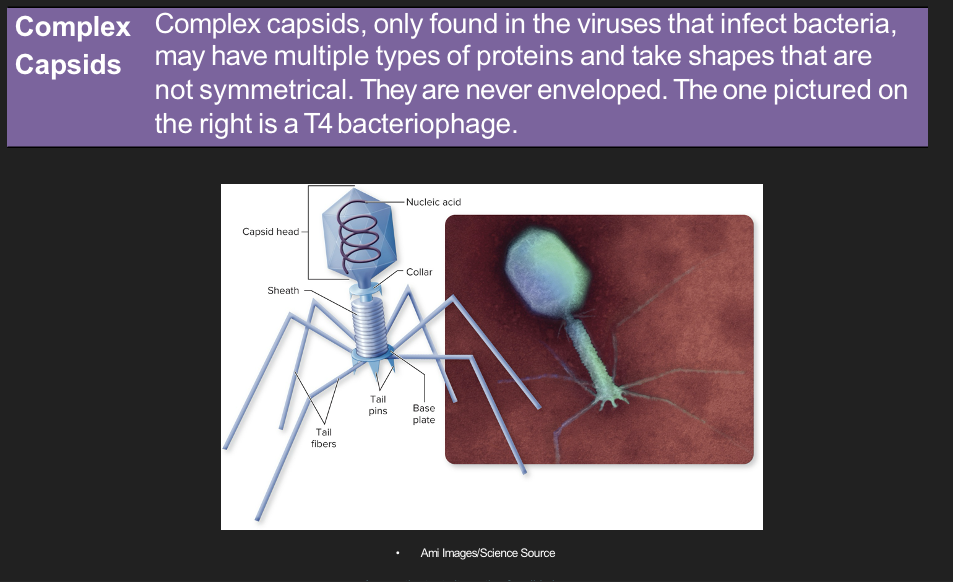
which type of virus is more often single-stranded—DNA or RNA viruses?
RNA viruses are more often single-stranded
what is a positive-sense RNA virus?
its RNA genome acts as mRNA, meaning it is ready for immediate translation into proteins by the host cells (SARS-CoV-2)
what is a negative-sense RNA virus?
its RNA genome must be converted into positive-sense RNA before translation can occur (e.g., Ebola, influenza, and rabies)
what is the general phases in the life cycle of animal viruses?
adsorption - the virus encounters a susceptible host cell and binds specifically to receptor sites on the cell membrane
penetration and uncoating - the entire virus is engulfed through endocytosis or fusion and enclosed in a vacuole or vesicle → the virus uncoat when the enzyme in the vacuole dissolve the envelope or capsid to release the genetic materials
synthesis: the viral nucleic acid begins to synthesis the building blocks for new viruses (do we need to know the specific mRNA?)
assembly: mature virus particles are constructed from the growing pool of parts - the capsid is first laid down as an empty shell that will serve as a receptacle for the nucleic acid strand - the virus insert its viral spikes into the host’s cell membrane so they can be picked up as the virus buds off with its envelope
release: assembled viruses leave their host in one of two ways - non-enveloped and complex viruses that reach maturation in the cell nucleus or cytoplasm are released when the cell lyses or ruptures while enveloped viruses are liberated by budding from the membrane of the cytoplasm
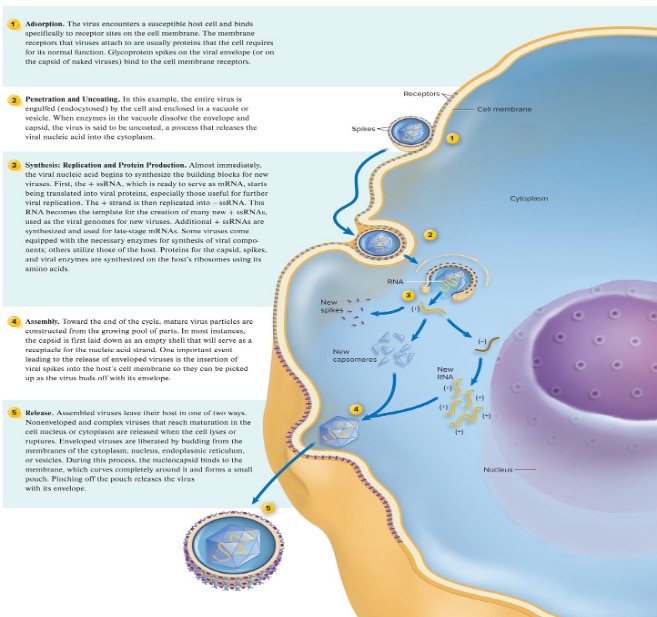
what is another name for retrovirus?
RNA virus
what do polymerases do in viruses?
they synthesize DNA from DNA (DNA → DNA) or RNA from DNA (DNA → RNA)
what is the function of replicases?
they synthesize RNA from an RNA template (RNA → RNA)
what does reverse transcriptase do?
it synthesizes DNA from an RNA template (RNA → DNA)
do most viruses have genes for metabolic enzyme syntehsis?
no, the vast majority of viruses completely lack these genes
what substances do some viruses carry away from their host cell?
some viruses take along specific host cell components (e.g. cell membrane → envelope)
what do arena-viruses pack along from their host cell?
host ribosomes
what retroviruses borrow from their host cell?
the host’s tRNA molecules
what is cytopathic disease?
disease caused by cell - damage or visible changes that occur in host cells as a result of viral infection
what is the cytopathic disease caused by respiratory synctial virus?
adjacent cells fuse together, forming a large cell within many nuclei (originating from the former single cells) → formed multinucleate cell called syncytium
what is the cytopathic disease caused by rabiesvirus?
cause the formation of inclusion bodies (e.g., toxins) in either the cytoplasm or nucleus of the host cell - accumulates structures called Negri bodies in their cytoplasm
what is a syncytium?
one giant cell
what is the cytopathic changes caused by smallpox virus?
cells round up - inclusions appear in cytoplasm
what is the cytopathic changes caused by herpes simplex?
cells fuse to form multinucleated syncytia; nuclear inclusion
what is the cytopathic changes caused by adenovirus?
clumping of cells; nuclear inclusions
what is the cytopathic changes caused by reovirus?
cell enlargement; vacuoles and inclusions in cytoplasm
what is the cytopathic changes caused by influenza virus?
cells round; no inclusions
what is the cytopathic changes caused by measles virus?
syncytia form (multinucleate)
what does it mean when a cell maintains a carrier relationship with a virus?
the cell harbors the virus but is not immediately lysed (destroyed)
what is a provirus?
viral DNA that becomes incorporated into the DNA of the host cell → once inserted, the viral genes can remain dormant (latent) for long periods or be transcribed along with the host’s genes, producing new viral particles later
which virus can behave as a provirus in brain cells, occasionally causing progressive damage?
the measles virus
what is a chronic latent state in viral infections?
a condition where latent viruses periodically become activated under various stimuli
are persistent infections always immediately destructive to the host cell?
no, in persistent infections, the virus may remain in the clel without killing it right away
true or false: about 20% of human cancers are caused by viruses
true
how does oncogenic viruses causes cancer?
some viruses carry genes that directly cause cancer
other viruses produce proteins that induce a loss of growth regulation, leading to cancer
examples:
retroviruses can do one of two things (1) viral oncogenes incorporates into host cell DNA and produce proteins that lead to uncontrolled cell growth or (2) viral genes affect expression of host oncogene leading to uncontrolled cell growth
DNA tumor viruses: viral genes directly produce proteins that lead to uncontrolled cell growth
what is a bacteriophage?
a virus that infects bacteria
phages attach to bacterial cells, inject their genetic material, and use the bacterial machinery to replicate (the name literally mean bacteria eater)
who discovered bacteriophages and when?
they were discovered in 1915 by Frederick Twort and independently in 1917 by Felix d’Herelle - d'Herelle coined the term bacteriophage after observing clear spots (plaques) on bacterial lawns, indicating bacterial lysis by viruses
what types of bacteria do bacteriophages infected?
they cna parasitize every known bacterial species - they are the most abundant biological entities on Earth, outnumbering bacteria by about 10 to 1
true or false: because of bacteriophages’s specificity, phages are used in phage therapy to target antibiotic-resistant bacteria
true
what kind of genome do most bacteriophages have?
most of phages have a double-stranded DNA (dsDNA) genome, although some have single-stranded DNA or RNA genomes
what are the chain of events in the lytic cycle of T-even bacteriophages?
adsorption
penetration
duplication of phage components; replication of virus genetic material
assembly of new virions
maturation
lysis of weakened cell
release of viruses
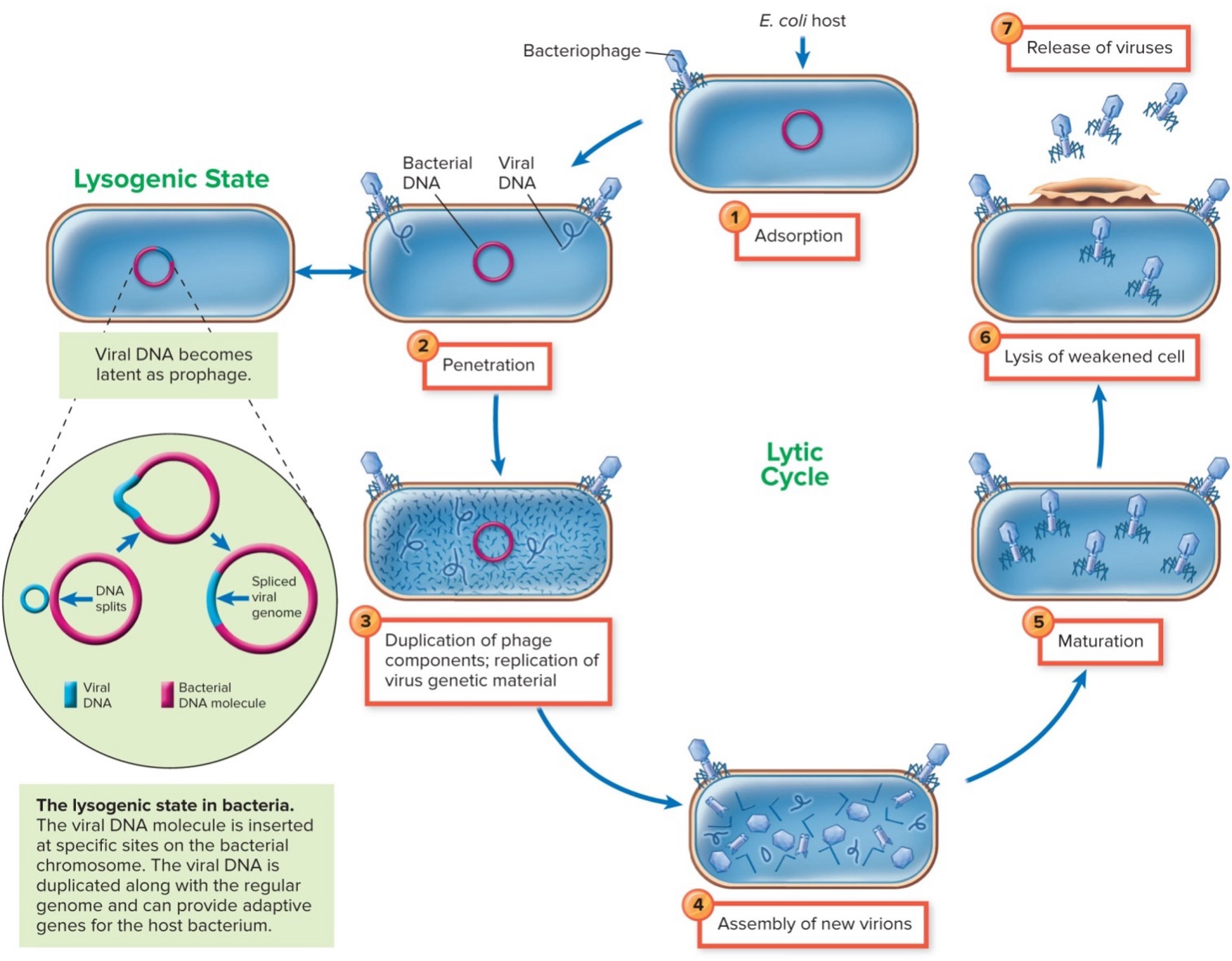
how can bacteriophages make bacteria more pathogentic to humans?
phages can carry virulence genes that they transfer to bacteria through lysogenic conversion )basically making the previously harmless bacteria produce toxins or resist antibiotics
what are the two main replication cycles of bacteriophages?
lytic cell - the phage replicates inside the host, then causes lysis (bursting) of the bacterium, releasing new phages
lysogenic cycle (lysogeny) - the phage DNA integrates into the bacterial chromosomes as a prophage and remains dormant, replicating along with the host cell until triggered to enter the lytic cycle
what happens during the lysogenic cycle (lysogeny)?
the phage DNA integrates into the bacterial genome → becomes a prophage
the bacterium continues to live and divide, copying the phage DNA with each division
environmental stress can trigger the prophage to reactivate and enter the lytic cycle
what is the main difference between the lytic and lysogenic cycles?
lytic cycle: virus immediately replicates and lyses (kills) the host cell
lysogenic cycle: viral DNA integrates into host DNA and stays dormant until triggered to become lytic
what can occasionally happen when phage genes are integrated into a bacterial chromosome?
the phage genes can cause the bacterium to produce toxins or enzymes that it would not normally make
what is lysogenic conversion?
lysogenic conversion occurs when a bacterium acquires a new trait from a temperate phage, often making it more pathogenic
what is a temperate phage?
a type of bacteriophage that can choose between two life cycles after infecting a bacterial cell
this type of phage does not always kill the host but it can wait patiently in lysogeny until conditions trigger the lytic cycle
what toxin does corynebacterium diphtheria produce due to lysogenic conversion?
the diphtheria toxin
what toxin does Vibrio cholerae produce due to lysogenic conversion?
the cholera toxin
what toxin does clostridium botulinum produce due to lysogenic conversion?
the botulinum toxin
why is lysogenic conversion medically significant?
It can turn harmless bacteria into dangerous pathogens by giving them genes for toxin production.
why do viruses require living cells as their “medium"?
because viruses are obligate intracellular parasites - they cannot reproduce or carry out metabolism outside a living host cell
what does in vivo mean in viral cultivation?
in vivo means growing viruses inside living organisms, such as laboratory-bred animals or embryonic bird tissues (e.g., chicken embryos)
what does in vitro mean in viral cultivation?
in vitro means growing viruses outside a living organism using cell or tissue culture methods (e.g., petri dishes or flasks of host cells)
what are the most common choice of egg for in vivo inoculation?
chicken
duck
turkey
what are prions made of?
prions are composed entirely of proteins - rhey contain no nucleic acid (no RNA or DNA)
is the exact mode of prion infection fully understood?
no, the exact mechanism is still being investigated, but prions are known to cause abnormal folding of normal cellular proteins in the brain
where are prions deposited in infected individuals?
prions accumulate as long fibrils in brain tissues, leading to spongy degeneration of the central nervous system
what disease do prions cause in humans?
creutzfeldt-jakob disease (CJD) - it affects the central nervous system, causing degeneration, demential, and death
what are the three ways Creutzfeldt-Jakob disease (CJD) can be acquired?
Genetic mutation (inherited form)
Sporadic CJD (appears without known cause)
Acquired CJD (from contaminated instruments or infected tissue)
what animal disease is related to human CJD?
bovine spongiform encephalopathy (BSE), also known as mad cow disease.
what do some viruses depend on for replication?
some viruses depend on other viruses (called helper viruses) for their replication
what is the adeno-associated virus (AAV)? can it infect cells on its own?
a virus that was originally thought to replicate only in cells infected with adenovirus but it can also replicate in cell infected with other viruses
yes, AAV can infect cells independently, but it cannot replicate without a helper virus like adenovirus or herpesvirus
what is the Delta agent (Hepatitis D virus)?
anaked circle of RNA that can only be expressed in the presence of the Hepatitis B virus (HBV) → an example of a satellite virus
what are viroids?
virus-like agents that parasitize plants composed of naked strands of RNA, lacking a capsid or any other type of coating
A 5-month-old female, accompanied by her parents, presents to the pediatrician’s office with a fever, dry mucous membranes, labored breathing, wheezing, and a harsh cough. Rapid testing of nasal swabs reveals respiratory syncytial virus infection. The RN arranges for transport to the hospital, where she will receive intravenous fluids and oxygen therapy.
RSV is caused by an RNA virus
what are the main differences between RNA and DNA viruses
DNA viruses are more stable and often cause chronic or latent infections because their DNA can integrate or persist in the host’s genome.
Examples: Herpes viruses (cold sores, shingles), Hepatitis B, Human papillomavirus (HPV).
Key idea: Long-term, sometimes hidden infections.
RNA viruses replicate quickly and usually cause acute, short-term infections since they don’t integrate into host DNA and mutate easily.
Examples: Influenza, Coronavirus (COVID-19), HIV (retrovirus using reverse transcriptase).
Key idea: Fast, short-lived infections that change rapidly.
🧠 Summary:
→ DNA viruses = stable, chronic/latent
→ RNA viruses = fast, acute, high mutation rate
A 5-month-old female, accompanied by her parents, presents to the pediatrician’s office with a fever, dry mucous membranes, labored breathing, wheezing, and a harsh cough. Rapid testing of nasal swabs reveals respiratory syncytial virus infection. The RN arranges for transport to the hospital, where she will receive intravenous fluids and oxygen therapy.
If the patient receives antibiotic therapy at the hospital, the RN would expect the patient’s duration of symptoms to be:
Increased
Decreased
Unchanged
unchanged - antibiotic is for bacteria…
A 5-month-old female, accompanied by her parents, presents to the pediatrician’s office with a fever, dry mucous membranes, labored breathing, wheezing, and a harsh cough. Rapid testing of nasal swabs reveals respiratory syncytial virus infection. The RN arranges for transport to the hospital, where she will receive intravenous fluids and oxygen therapy.
The patient’s parents question which antibiotic will be given to treat their daughter’s infection. You inform her that:
Antibiotics target bacterial cells and do not work on viruses
Her daughter will be tested for antibiotic sensitivity before they are given
Antibiotics target eukaryotic cells and do not work on viruses
Her daughter is too young to receive antibiotic therapy
Antibiotics target bacterial cells and do not work on viruses
A 5-month-old female, accompanied by her parents, presents to the pediatrician’s office with a fever, dry mucous membranes, labored breathing, wheezing, and a harsh cough. Rapid testing of nasal swabs reveals respiratory syncytial virus infection. The RN arranges for transport to the hospital, where she will receive intravenous fluids and oxygen therapy.
What is the rationale for providing IV fluids and oxygen support for this patient?
1.These will increase the patient’s immune response
2.These will augment antiviral treatment for RSV
3.These will prevent secondary respiratory infection while the patient is compromised
4.These are supportive therapies while the disease runs its course
These are supportive therapies while the disease runs its course
Which of the following environmental factors are likely to have the greatest influence on microbial growth? More than one answer is correct.
Multiple select question.
pH
pressure
temperature
rock formation
gases such as carbon dioxide and oxygen
gases such as helium and argon
pH, pressure, temperature, and gases such as carbon dioxide and oxygen
What word is used to describe organisms which can use oxygen in their cellular respiration pathways?
Multiple choice question.
Aerobic
Oxygenators
Anaerobic
Oxygenobic
aerobic